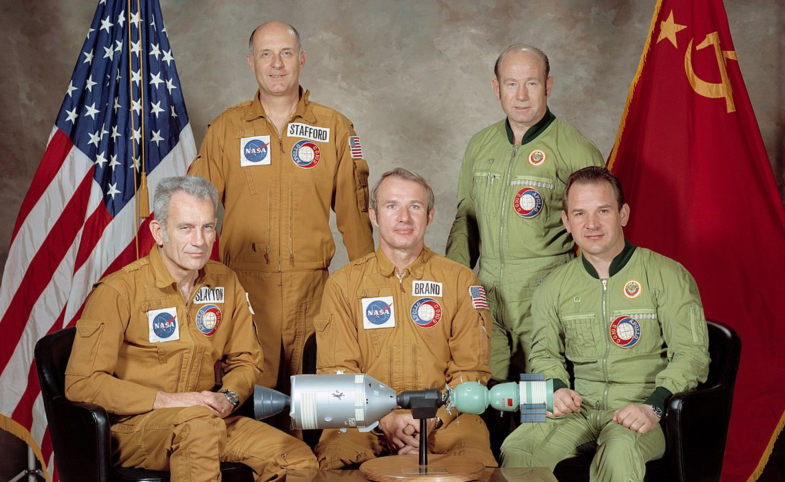The CPD Blog is intended to stimulate dialog among scholars and practitioners from around the world in the public diplomacy sphere. The opinions represented here are the authors' own and do not necessarily reflect CPD's views. For blogger guidelines, click here.

Revisiting 1975's Apollo-Soyuz Mission
July 15, 2025 marks the fiftieth anniversary of the Apollo-Soyuz mission. This was a unique scientific and engineering experiment involving two spacecraft — one Soviet and one American — that were launched independently before docking in orbit. The feat was the prototype for the Shuttle-Mir program and the International Space Station, which is currently operational.
This astonishing historical example of successful cooperation between two competing superpowers during the Cold War is often considered a case of science diplomacy. The relationship between scientific and technological achievements, and foreign policy, creates an avenue for science diplomacy. Although the concept of science diplomacy is relatively new, history is full of examples of it.
The term “science diplomacy” emerged in academic and practitioner vocabulary in the early 2000s. The US became a pioneer and trendsetter of this concept, with one of the main ideas to use scientific cooperation to improve interstate relations. The concept was further developed with an idealistic approach, with science diplomacy being positioned as the ultimate instrument for addressing global issues and achieving the Sustainable Development Goals. Science diplomacy was also recognized as a means of promoting international scientific collaboration and as a fundamental aspect of global governance. It was also considered a way of encouraging economic and technological development and of attracting financial investment to developing countries.
The adoption of the concept by a wide range of state and non-state actors has led to it becoming blurred, as every international actor understands and interprets science diplomacy in their own way, for various purposes, and in different contexts. All of these purposes and hopes are valid and have their own rationale. However, recent years have shown that such ultimate goals are difficult to achieve. The United States' withdrawal from the WHO and the Paris Agreement, as well as the imposition of western scientific sanctions against Russia, indicate the limits of science diplomacy and shatter the positions of global institutions. This is not because science diplomacy is a weak concept, but rather because expectations were unrealistic in the face of the prevailing structural factors of the international system and the national interests of countries.
Revisiting the Apollo-Soyuz mission could help us understand the purpose of science diplomacy and what can realistically be achieved. Science diplomacy can be assessed from three angles: (1) as an extension of public diplomacy; (2) as a means of fostering scientific cooperation to improve interstate relations; and (3) as a means of providing institutional support. All of these should correspond with a nation-state’s foreign policy goals and interests.
"Revisiting the Apollo-Soyuz mission could help us understand the purpose of science diplomacy and what can realistically be achieved."
(1) Science diplomacy is an extension of public diplomacy, allowing communication with foreign audiences to create a positive international image. Indeed, a wide range of communication was involved before the mission was accomplished. For example, Russian cosmonauts and American astronauts participated in joint exercises and preparatory processes, which also included language training. Above all, the work of scientists and engineers was indispensable in completing this mission. In total, Russia and the US spent five years preparing and working closely together. At a state level of media and diplomatic communication, all these processes were publicly discussed, demonstrating the capabilities of the two superpowers in space science and exploration. It was a message not only to the Soviet and American people, but to the whole world, demonstrating the might of scientific achievements in reaffirming superpower status.
(2) The Apollo-Soyuz mission was all about scientific cooperation. Notably, the two countries had a comparable level of scientific expertise. The Russians were the first in space, while the Americans were the first on the Moon. Both countries had their own spaceships which only required the unifying docking mechanism invented by Russian engineer Vladimir Syromyatnikov. Scientific cooperation was not about to lead to a breakthrough in scientific achievement. Rather, it was about maintaining an open line of communication between states amid political tensions. Therefore, scientific cooperation could be perceived as track two diplomacy. Although the mission improved relations between the two countries, it didn’t mean to address the structural factors of national security strategies or the conflicting ideological and geopolitical stances.
(3) The Apollo-Soyuz project was highly institutionalised. It all began with the explicit political will of Richard Nixon and Leonid Brezhnev. A lengthy process of preliminary negotiations was followed by the signing of a cooperation agreement in 1972, with both countries’ diplomatic efforts involved at every stage of the mission. The legal diplomatic framework was crucial not only for achieving the mission’s primary objective, but also for paving the way for the future implementation of space cooperation. It delved deeper into the Shuttle-Mir and ISS projects.
The institutionalization of scientific and technological cooperation has vital outcomes nowadays. Since the conflict in Ukraine began in 2022, the U.S. and Russia have displayed opposing objectives and national interests with regard to the conflict. Despite the wide range of U.S. economic sanctions against Russia, the ISS remains operational. In July 2022, Roscosmos and NASA signed a seat-swap agreement, enabling Russian cosmonauts to travel to the ISS on U.S. spacecraft and U.S. astronauts to travel on Russian spaceships. This agreement has never been violated, has been extended several times, and is currently valid until 2027.
In short, science diplomacy is a sophisticated diplomatic tool that, when understood and used properly, can help a nation-state achieve its foreign policy goals. It involves the compatibility of scientific achievements, the explicit need to keep communication channels open, and the reaffirmation of a leading scientific power status belonging to an advanced space club. The club establishes norms and rules within an institutional space, thereby encouraging further cooperation in outer space, as demonstrated by the Apollo-Soyuz Project.
Visit CPD's Online Library
Explore CPD's vast online database featuring the latest books, articles, speeches and information on international organizations dedicated to public diplomacy.
POPULAR ARTICLES
-
November 3
-
November 5
-
November 13
-
November 25
-
December 17
Join the Conversation
Interested in contributing to the CPD Blog? We welcome your posts. Read our guidelines and find out how you can submit blogs and photo essays >.









